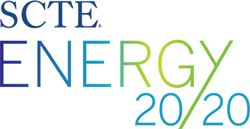I See Fields of Green
By Derek DiGiacomo
Spring and summer have always been two of my favorite seasons. I appreciate all four seasons in the mid-Atlantic states but with the sight of spring flowers, warmer breezes and more hours of sunlight, the spirits have much to sing about. Adding to the spring excitement, our SCTE Energy 20/20 program hosts the first of two annual hybrid meetings where the industry gathers to work on sharing cutting edge information and drafting influential industry go-to documents that lay the groundwork for positive change. Our mission to enhance sustainability and improve energy management techniques have made the semi-annual gatherings a priority on team members’ schedules!
This past April we were fortunate to visit our host Comcast, in Philadelphia, to cover the latest hot topics. Key discussions focused on: outside plant powering, critical facility energy storage, and a cable operator case study on energy conservation measures. We also heard from a utility industry subject matter expert who offered ideas of how our two industries could collaborate.
We now turn our sights to the fall and SCTE® Cable-Tec Expo® 2023. As the program continues to shape up with the call for abstracts concluded and the selection committee putting the finishing touches on their choices for the Fall Technical Forum track participants, I am confident that there will be a solid representation of topics focused on sustainability and energy to energize attendees. We also eagerly await our annual Energy 20/20 update at the event, as that is one of my favorite sessions and a fan favorite at the show.
A circular focus on energy
In the spring edition of SCTE’s Technical Journal, I wrote a letter to the editor where I asked several questions. Let me take a moment to respond to one now that I’ve had time to reflect and discuss this topic with some of the industry’s most influential individuals. Let me expand on thought four of that letter — “How is an energy circularity mindset going to impact our ability to grow the service offerings?” Starting with a definition, circularity, as it pertains to energy, is the consumption of power throughout the end-to-end process of producing a product or service. For circularity, it isn’t simply just the energy at the plug of the device, it is how much energy went into the manufacturing of the device itself, energy to move the product, and ultimately retire the product when no longer useful in its state. Embracing the idea of circularity from the onset during design of the product or service can have profound impacts on our energy and greenhouse gas legacy. Otherwise, with current and projected greenhouse gas emissions, we are poised to leave future generations a grim legacy of climate upheaval.

It has been said that a picture is worth a thousand words, and I really like the way the accompanying figure captures the essence the circularity mentality. Note how exhaustive the process is, doing everything that can be done to prevent the product from entering landfill.
I would like to add one more item to the process, and that is the step of rethinking. Leading with questions that promote creative ways to address outdated ways, influence culture and impact the most basic parts of the equation, is a healthy practice for business and the planet. Less mining of raw materials in and of itself should use less energy.
Embracing the concept of circularity requires an out of the box way of thinking. Circular, to be exact. Engaging all stakeholders in the value chain: mining, manufacturing, transportation, government, retailers, customers, and end of life companies all need to have a voice and be listened to. If we default to the familiar, “It’s always been done that way,” train of thought, progress to purpose will stall, risks will continue to rise, and future generations will be placed in an even more difficult situation than where we are today. Let us leverage the amazing networks we have built and will be growing to help promote and embrace the healthy approach to managing our industry ecosystem.
Diving in a bit deeper, taking materials already in the supply chain and reclaiming them for use by improving products is a wonderful target. Realistically, not everything in the supply chain can be reclaimed currently, but reuse attitudes are beginning to bloom. What nascent businesses will specialize in transformation of the old and make raw materials viable again? Will it be the mining industry looking to diversify, will it be a start-up, will it be a government body? Perhaps it will be a major user of the material itself looking to drive positive changes. The wheel is in motion, and I am hopeful we will see how fast it can turn.
Energy is an enabler and another area that is worth watching is energy storage. Access to power when, where, and in the quantity needed will continue to be essential for modern society. All sectors of society that rely on a digitally driven world need energy. The cable broadband industry is no exception and in fact, we perform “magic” by turning the electrons into bits and bytes that have value to anyone using them. Everything from healthcare to entertainment to education depends on communication driving information. Taking a look at the supply of power from the grid can be a first step to moving to a circular approach to power.
When contracting with power providers, ask if they offer renewable energy solutions. From there, look at backup power for critical infrastructure, see what the total plan is for reclaiming spent materials when they are no longer able to provide the chemical conversion necessary to carry essential loads. How can the manufacturer aid in repurposing the minerals responsible for power storage? Examine what innovative energy storage technology or chemistries can be embraced to reduce the volume of raw materials needed in the first place.
Finally, how can we become more invested in the power marketplace? The launch of Gridmetrics is a strategic venture to obtain information about the supply of electricity. How will we take that to the next level with more intelligence, critical decision aids, and influence over where we secure power?
I mentioned at a past Energy 20/20 meeting that we as an industry will continue to innovate, discuss, and deploy the best energy conservation methods until power is universally green and nearly free. It is vital to continue to prioritize our strategic thinking about one of our industry’s (and society’s!) most important assets – power and its supply chain.
May our future be bright and move in that circular motion!

 Derek DiGiacomo
Derek DiGiacomo
Senior Director of Energy Management Programs and Business Continuity, SCTE®, a subsidiary of CableLabs®
Derek DiGiacomo is the Senior Director of Energy Management Programs and Business Continuity at SCTE®, a subsidiary of CableLabs®. Under DiGiacomo’s leadership, SCTE, the not-for-profit member organization for cable telecommunications, has seen a dramatic 50% reduction in the dependency on grid power using a renewable power-based microgrid that extends critical system runtime to seven days on average. Derek is a National Renewable Energy Labs (NREL) 2017 Energy Exec alumni.
Images provided by author
Shutterstock




